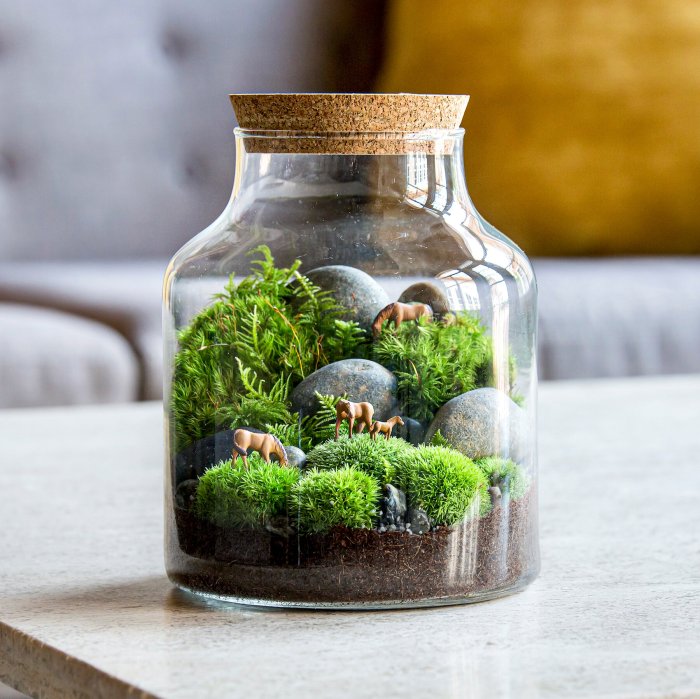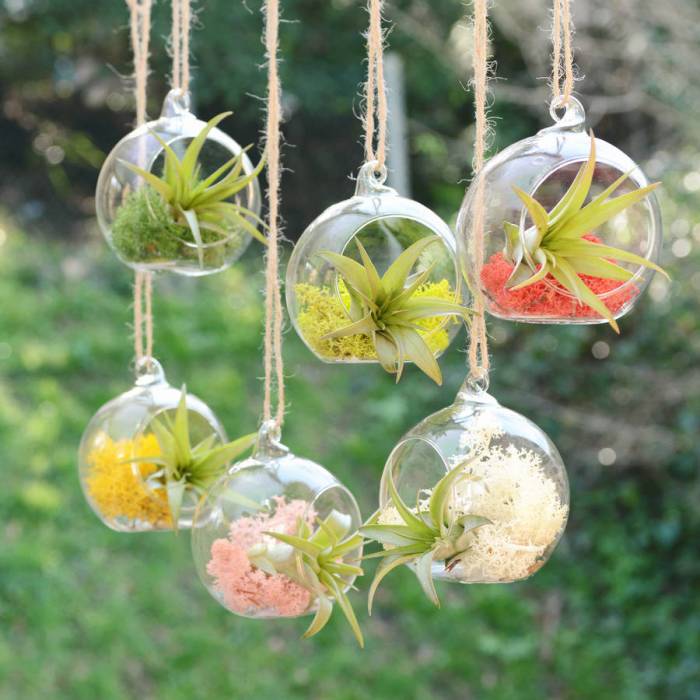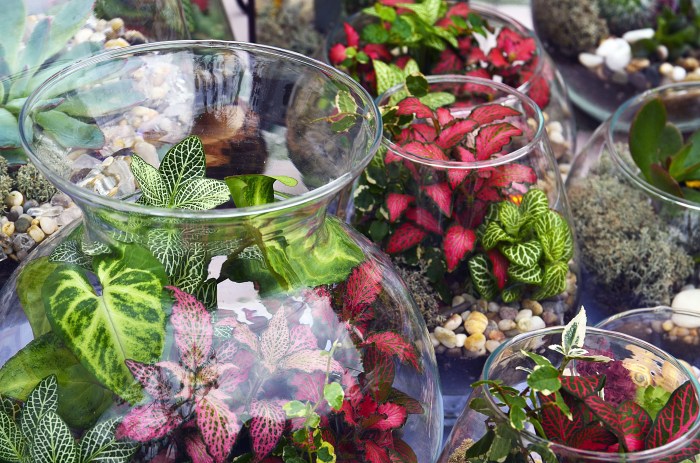Best plants for a small terrarium, a guide to help you select the perfect plants for your miniature ecosystem. With the right plants, you can create a thriving terrarium that will bring life and beauty to your home.
When choosing plants for a small terrarium, it is important to consider the size and growth patterns of the plants. You will also need to choose plants that have similar water and light requirements. With a little planning, you can create a beautiful and thriving terrarium that will bring you years of enjoyment.
Ideal Plant Species
For thriving ecosystems in small terrariums, specific plant species excel due to their adaptability to confined spaces and minimal maintenance needs. These diminutive wonders not only enhance the aesthetic appeal of terrariums but also contribute to the overall balance and well-being of the miniature environment.
When selecting plants for a small terrarium, consider their growth habits, light requirements, and compatibility with other species. Some ideal choices include:
Suitable Plant Species
- Ferns:Delicate and graceful, ferns add a touch of elegance to terrariums. They prefer moist, shady environments and can tolerate low light levels.
- Mosses:Tiny and versatile, mosses create a lush, carpet-like effect. They require high humidity and can grow on various surfaces.
- Air Plants:These epiphytes absorb moisture and nutrients from the air, making them ideal for terrariums with limited soil space. They come in various shapes and sizes, adding visual interest.
- Peperomia:With their compact size and colorful foliage, peperomia plants bring a splash of color to terrariums. They prefer bright, indirect light and well-drained soil.
- Fittonia:Known for their intricate leaf patterns, fittonia plants add a touch of whimsy to terrariums. They thrive in humid environments and prefer filtered light.
Terrarium Design Considerations

Creating a successful small terrarium requires careful consideration of plant size and growth patterns, substrate composition, and drainage. These elements play crucial roles in maintaining plant health and achieving a visually pleasing arrangement.
Plant Size and Growth Patterns
In small terrariums, plant size and growth patterns are essential factors to consider. Choosing plants that remain relatively small and compact is essential to prevent overcrowding and ensure adequate air circulation. Consider plants with slow or controlled growth rates to minimize the need for frequent pruning or maintenance.
When creating a small terrarium, selecting the right plants is crucial. For those seeking an enduring and graceful addition, the Ribbon Fern, meticulously detailed in the article Ribbon Fern: An Enduring Beauty Unveiled , stands out. With its delicate fronds and ability to thrive in humid environments, it effortlessly elevates the aesthetic appeal of any miniature ecosystem.
Substrate Composition and Drainage
The substrate in a terrarium provides anchorage and nutrients for plants. For small terrariums, a well-draining substrate is vital to prevent waterlogging, which can lead to root rot and other plant health issues. A mixture of potting soil, perlite, and charcoal can provide the necessary drainage and aeration while retaining moisture.
Balanced and Visually Pleasing Layout
Creating a balanced and visually pleasing terrarium layout involves considering plant height, color, and texture. Arrange taller plants towards the back or center, while shorter plants can be placed in the foreground or along the sides. Use a variety of leaf shapes and colors to add interest and depth to the terrarium.
Avoid overcrowding by leaving some open space to allow for air circulation and growth.
Plant Care and Maintenance

Preserving the vitality of plants in a confined terrarium environment demands meticulous attention to their specific needs. Watering, lighting, and humidity levels play pivotal roles in ensuring their well-being. Additionally, regular maintenance is essential to prevent common problems and maintain optimal conditions.
For those looking to create a miniature garden in a small terrarium, there are several plants that are ideally suited for this purpose. These include ferns, mosses, and small succulents. However, it is important to be aware of potential issues that may arise, such as the development of spots on the plants.
If you notice any unusual markings, refer to the comprehensive guide at Spots on Plant: A Comprehensive Guide to Identification Prevention and Treatment for expert advice on identifying, preventing, and treating these issues. This will help ensure that your terrarium plants remain healthy and vibrant.
Watering
Overwatering poses a significant threat to terrarium plants, as it can lead to root rot and other issues. The frequency of watering depends on the plant species, terrarium size, and environmental conditions. As a general rule, water only when the soil surface feels dry to the touch.
Avoid saturating the soil, and allow excess water to drain from the drainage holes.
Lighting
Most terrarium plants require bright, indirect light to thrive. However, the intensity and duration of light exposure can vary depending on the species. Some plants may tolerate lower light levels, while others require more intense illumination. Consider using grow lights to supplement natural light if necessary.
Humidity
High humidity levels are crucial for many terrarium plants. To maintain humidity, mist the plants regularly or use a humidifier. Covering the terrarium with a lid or plastic wrap can also help trap moisture. However, ensure proper ventilation to prevent condensation and mold growth.
Preventing Common Problems, Best plants for a small terrarium
Overwatering, pests, and diseases are common challenges in terrariums. Overwatering can be prevented by following proper watering practices. Inspect plants regularly for signs of pests or diseases, and treat them promptly with appropriate measures.
Regular Maintenance
Regular maintenance is essential for the health and longevity of terrarium plants. Pruning helps control growth and shape, while cleaning removes debris and prevents algae buildup. Check plants regularly and perform maintenance as needed to ensure optimal conditions.
Creative Terrarium Ideas

Terrariums offer a unique opportunity to showcase creativity and ingenuity in gardening. By incorporating innovative designs, unique elements, and thoughtful plant selection, you can create captivating miniature ecosystems that bring the beauty of nature indoors.One innovative approach is to maximize space by utilizing vertical terrariums.
For a small terrarium, ferns, mosses, and succulents are excellent choices due to their compact size and low maintenance requirements. If you’re seeking additional options for your terrarium, consider exploring hanging plants bunnings . After browsing their extensive selection, you can return to selecting the ideal plants for your terrarium’s microenvironment.
These designs feature multiple levels, allowing you to cultivate a diverse range of plants within a compact footprint. This approach is ideal for small spaces or those looking to add a touch of greenery to vertical surfaces.Incorporating natural elements such as rocks, driftwood, and decorative accents adds depth and character to your terrarium.
Rocks provide stability and create microclimates for different plant species, while driftwood offers a rustic touch and serves as a support structure for climbing plants. Decorative accents, such as figurines or small sculptures, can add a whimsical or artistic touch.The
shape and size of your terrarium also play a crucial role in enhancing aesthetics. Cylindrical or spherical terrariums create a sense of enclosure and focus, while open terrariums offer a more expansive view of the plant life within. Smaller terrariums are perfect for delicate plants or creating intimate displays, while larger ones can accommodate a wider variety of species and create a more immersive experience.
Benefits of Small Terrariums: Best Plants For A Small Terrarium

Small terrariums are self-contained ecosystems that offer a wealth of therapeutic and aesthetic benefits. They bring a touch of nature indoors, creating a sense of tranquility and well-being.
For those looking to create a verdant oasis in a small space, consider the best plants for a small terrarium. From delicate ferns to vibrant mosses, these miniature ecosystems offer a unique way to bring nature indoors. To delve deeper into the world of indoor greenery, explore Discover the Allure of Indoor Plant Stores: A Guide to Greenery and Decor for expert tips on selecting and caring for plants in small spaces, including terrariums.
Studies have shown that interacting with plants can reduce stress levels, improve mood, and enhance cognitive function. The lush greenery and miniature landscapes of small terrariums provide a soothing and restorative environment.
Air Quality Improvement
Small terrariums also contribute to improved indoor air quality. Plants release oxygen and absorb pollutants, creating a healthier indoor environment. They can help remove harmful toxins, such as formaldehyde, benzene, and trichloroethylene, which are commonly found in homes and offices.
Educational Value
Terrariums offer a unique educational opportunity to foster an appreciation for nature. They provide a hands-on way to observe the life cycles of plants and the delicate balance of ecosystems. Caring for a terrarium teaches children and adults alike about the importance of plant care, environmental stewardship, and the interconnectedness of living organisms.
Last Word
Small terrariums are a great way to add a touch of nature to your home. They are also a great way to learn about plants and how they grow. With the right care, your small terrarium can thrive for years to come.
Commonly Asked Questions
What are the best plants for a small terrarium?
Some of the best plants for a small terrarium include ferns, mosses, and small succulents.
How do I care for a small terrarium?
Small terrariums need to be watered regularly, but not too much. They also need to be placed in a location with bright indirect light.
How often should I clean my small terrarium?
You should clean your small terrarium every few months. This involves removing any dead leaves or debris, and wiping down the sides of the terrarium with a damp cloth.